To read the full report, please download PDF.
BoJ caution limits yen buying but downside limited
FX View:
The US dollar has rebounded notably in the aftermath of the FOMC meeting on Wednesday which was very much a reflection of market pricing rather than the communications from the Fed. Indeed, our own text analysis of the statement and Powell’s comments confirmed to us that the FOMC was actually more dovish. But the market was just positioned even more dovishly. The US dollar (DXY) is now 1.6% stronger from the intra-day low on Wednesday. Still, the medium-term outlook remains the same and we maintain our view of a further weakening of the US labour market, more rate cuts with the risk of the market being under-priced for what is delivered greater than the risk of being over-priced. The FOMC meeting was followed today by the BoJ meeting and while there were some hawkish elements to this meeting (two votes for an immediate hike) the communications from Governor Ueda remained cautious (although a bit more hawkish than before). Politics may have curtailed Ueda’s ability to send a more hawkish message but we still expect a hike in October (if Koizumi wins the election) and for the yen to then recover.
POST-FOMC LIFT FOR THE US DOLLAR VERSUS MOST G10 CURRENCIES
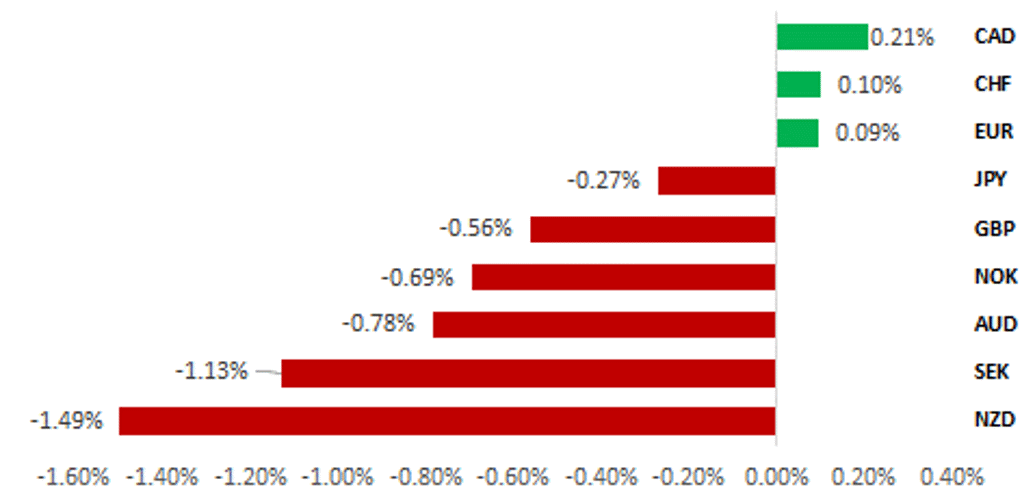
Source: Bloomberg, 13.00 BST, 19th September 2025 (Weekly % Change vs. USD)
Trade Ideas:
We recommending a new long EUR/GBP trade idea. We have closed our short USD/JPY trade idea and are maintaining a long NZD/SEK trade idea.
JPY Flows – Portfolio, by investor:
The monthly cross-border flow data by investor for August revealed strong buying of foreign bonds by Japan trust with that buying partially offset by Japan banks selling.
Hawkish-Dovish Sentiment Analysis:
Following the Fed’s latest policy decision, our Hawk-Dove Index (HDi) has turned negative for the first time in 12 months, signalling a notable dovish shift in communication. As a result, we do not expect the initial USD rebound to prove sustainable.
FX Views
JPY: Politics likely curtailed BoJ guidance
The two highlights from today’s BoJ meeting gave this meeting a hawkish leaning but the yen is close to unchanged versus the US dollar. This in part reflects the strength of the dollar which has advanced versus every other G10 currency today with momentum positive in the aftermath of the rebound following the FOMC meeting on Wednesday. The first of the two hawkish elements was the dissent by two policy board members – Hajime Takata and Naoki Tamura – who voted for an immediate 25bp hike. Both are known hawks so in that sense it wasn’t a surprise but this dissent today is significant. There have been dissents by two members but generally dovish dissents – July 2024 for example. But hawkish dissents have in the past been by just one member – December 2024 for example. Going back as far as 2000 we can’t see any examples of a two-member dissent favouring hawkish action. Secondly, the ETF and J-REIT holdings reduction plan was also a surprise but less of a surprise given Reuters had reported the possibility. The BoJ completed its sales of equities in July and hence turning its attention to ETFs and J-REITs was always a possibility. The pace of reduction is cautious (0.05% of trading values) with the ETF market value of the book total (JPY 37.2trn) at JPY 76.8trn as of the end of March.
However, the press conference did not reinforce these hawkish elements and overall the tone of the comments from Governor Ueda were largely similar to before. The statement prior had made reference to the ongoing uncertainties as reason to paying “due attention to the impact of these developments on financial and foreign exchange markets and on Japan’s economic activity and prices”. There was also a reference to downward pressure on corporate profits from tariffs and Governor Ueda made reference to these uncertainties. While Governor Ueda repeated the common guidance that there would be further rate hikes if the BoJ’s economic outlook was realised there was no sense of any greater degree of urgency. Still, OIS forward rates jumped and a hike in October is now viewed as a little over a 50% probability, up from 30% before the meeting. The yen is still the best performing G10 currency today although the gain versus the dollar is marginal.
We believed ahead of today’s meeting that Governor Ueda was in a difficult position given the LDP leadership election is scheduled for 4th October and hence it is uncertain who will be prime minister at the time of the next policy meeting on 30th October. The formal kick-off of the leadership election takes place on Monday but at this stage there are two clear front-runners – Shinjiro Koizumi and Sanae Takaichi. A Jiji Press opinion poll published yesterday revealed that 23.8% of respondents from the general public believe Koizumi is the best candidate followed by 21% who believed Takaichi was the best. The next closest (Hayashi and Motegi) polled just 5.9% underlining the high probability that this is a two-horse race. A Kyodo News poll published last Friday had the result the other way with Takaichi on 28% and Koizumi on 22.5%. Among LDP supporters only the Kyodo News poll indicated much stronger support for Koizumi who polled 36% compared to 15.7% for Takaichi.
BOJ HOLDINGS OF ETFS & J-REITS (BOOK VALUE)
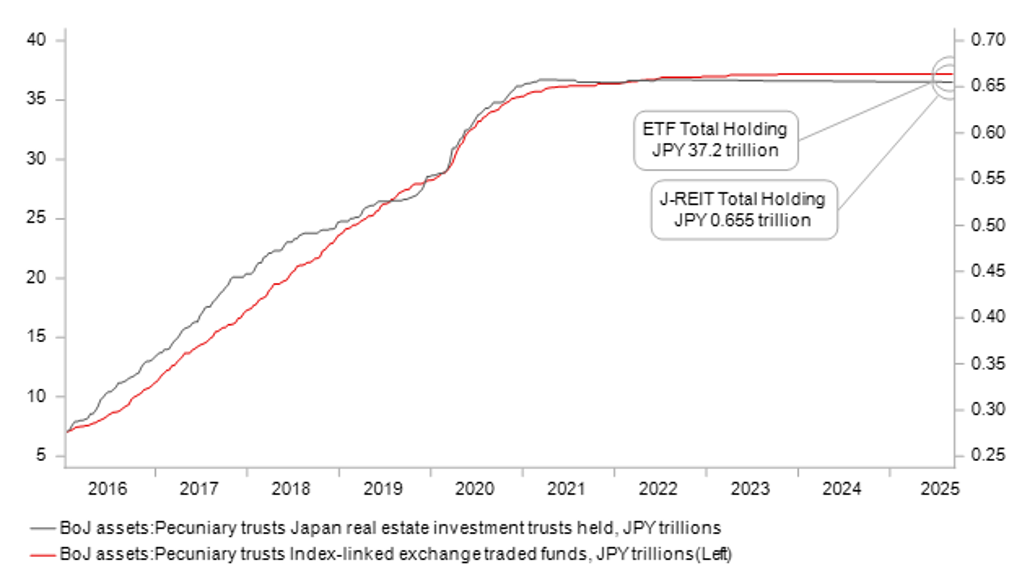
Source: Bloomberg, Macrobond & MUFG GMR
FRAGILE JGB MARKET A PROBLEM FOR TAKAICHI
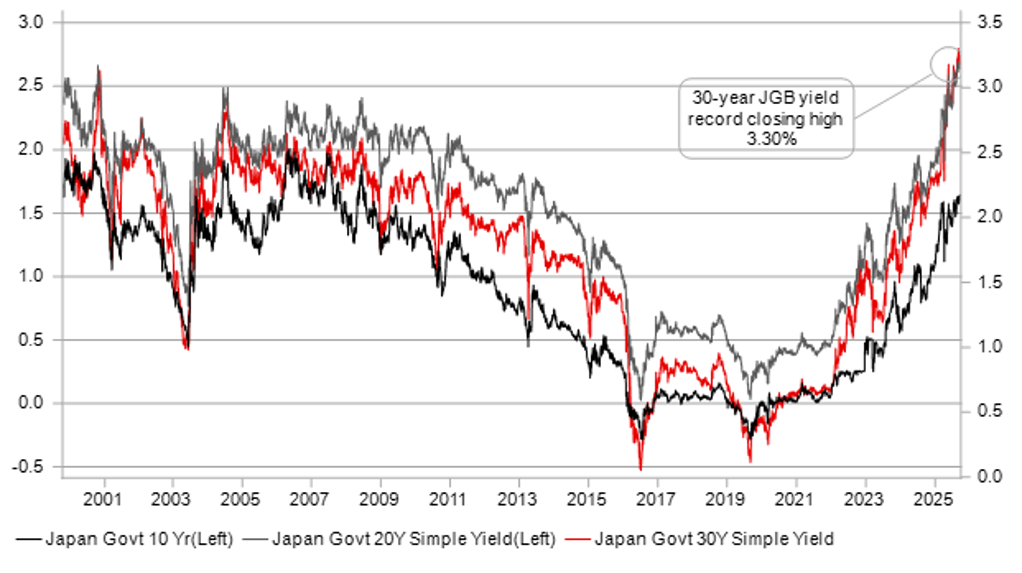
Source: Bloomberg, Macrobond & MUFG GMR
This is important given the framework of the upcoming election. 50% of the vote will be amongst the LDP lawmakers with the other 50% made up of votes amongst LDP members across the country. So this means there will be 295 lawmaker votes plus 295 grass-root votes weighted across roughly 1 million LDP members to give a total of 590 votes. If no candidate surpasses 50% then the top two will go to a second round of voting. In the second round the LDP lawmakers and the representatives from each of the 47 prefectures will vote. The second vote will total 342 (295 LDP lawmakers and 47 prefecture reps). So the weighting of grass-root support will drop dramatically in round two, to just 14% and hence LDP lawmakers’ say remains crucial.
Sanae Takaichi today laid out her policy agenda underlining that her policies will transform “anxieties into dreams and hopes”. Takaichi emphasised fiscal stimulus through a refundable tax credit program of tax cuts and direct cash benefits while also raising the minimum taxable income threshold. Notably there was little said about the monetary policy of the BoJ, which in the past Takaichi has been critical of the monetary tightening direction. Takaichi’s stance could be a concern amongst senior LDP members and given the fragility of the JGB market could undermine potential support. Furthermore, the sense of Takaichi being aligned with the Abenomics policies of the past, which were geared toward lifting Japan out of deflation, could also work against Takaichi with a growing sense that the party needs a resetting and to focus more on tackling the cost of living crisis that was the root cause of the LDP’s poor election result. In that sense, Koizumi could be viewed as a better alternative. Finally, Koizumi has the support of former PM Suga. Suga is close to the leader of the Restoration Party (Nippon Ishin) and is viewed as a potential coalition party. The LDP+Komeito coalition currently hold 220 seats, 13 short of a majority. Ishin hold 38 seats and is the third largest party. A stronger prospect of a coalition with Ishin and hence political stability could be delivered more easily for Koizumi with the support of former PM Suga.
Hence we expect Shinjiro Koizumi to win the leadership election on 4th October which could see 2-3 big figures of risk premium removed from USD/JPY. A Koizumi victory could then trigger some clearer communications from the BoJ over the prospect of a rate hike on 30th Oct. With US equities and many markets globally at record highs, the justification for continued caution is not compelling. With the FOMC set to cut further, the 3mth rates spread (a key gauge of hedging costs for Japanese investors) is likely to shrink notably and fuel renewed appetite for dollar-selling hedging activity.
3MTH SPREAD & USD/JPY – HEDGING COSTS TO FALL
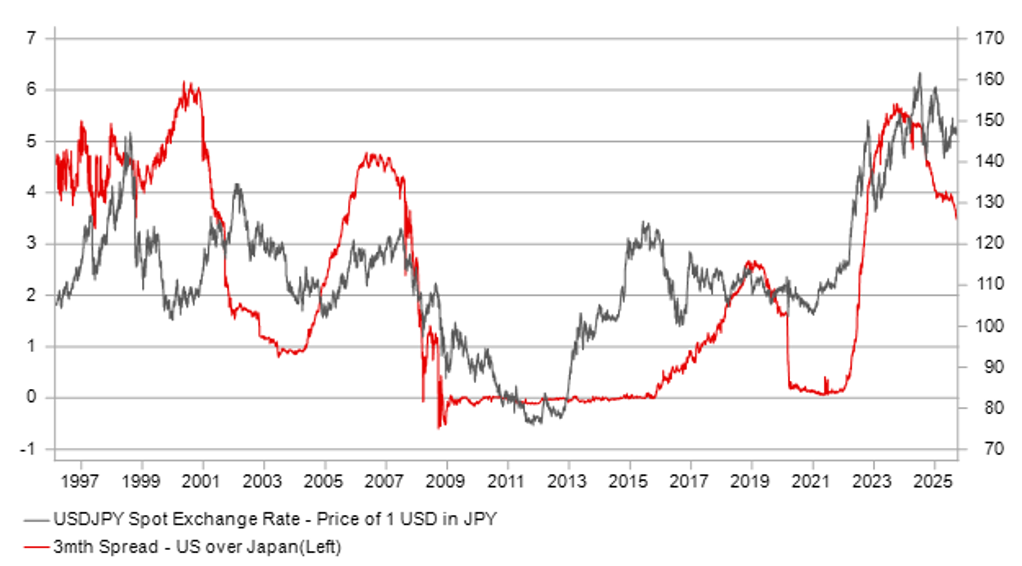
Source: Bloomberg, Macrobond & MUFG GMR
KOIZUMI WIN SHOULD HELP STEP JGB STEEPENING
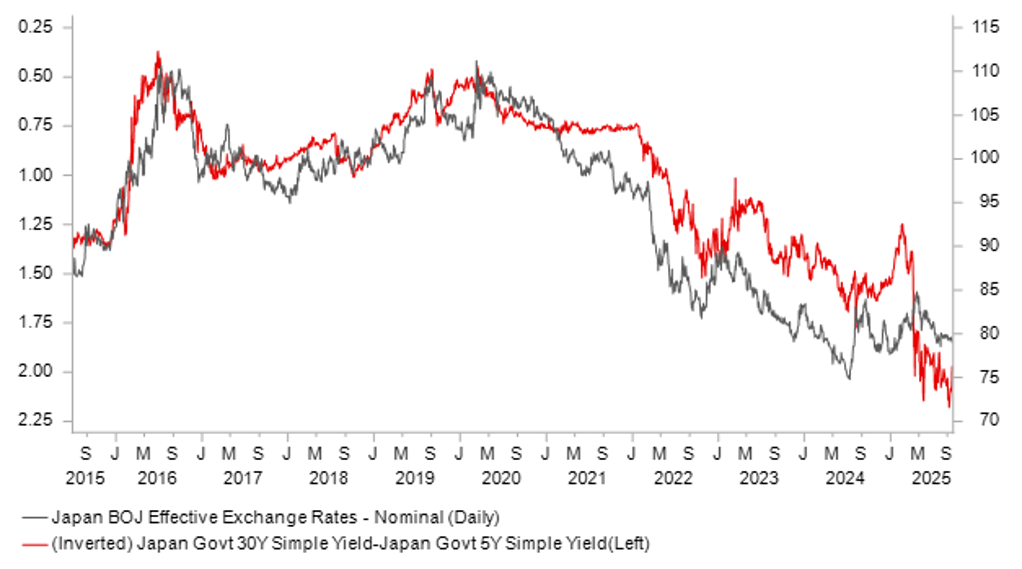
Source: Bloomberg, Macrobond & MUFG GMR
CHF: Downside risks from negative rates in focus ahead of SNB meeting
The CHF has been the best performing major currency over the past month reversing losses sustained in early August following President Trump’s decision to impose a much higher tariff of 39% for Switzerland. The higher tariff for Switzerland became effective from 7th August, and initially contributed to a weaker CHF. After threatening to break lower at the end of July, EUR/CHF rose to a high of 0.9457 on 18th August. However, the pair has since fallen back towards the bottom of the narrow trading range between 0.9300 and 0.94000 that has been in place for most of the time since May. The CHF has performed even better against the other major currencies of the JPY and USD hitting fresh year to date highs over the past week.
The higher 39% tariff has increased downside risks for Switzerland’s economy and encouraged speculation during 1H August that it could prompt the SNB to more seriously consider re-introducing negative rates in Switzerland. However, market expectations for the SNB to re-introduce negative rates have since eased back ahead of next week’s SNB policy meeting. In a recent interview on 8th September, SNB Chairman Schlegel stated “we are aware that negative interest rates can have undesirable side effect…The hurdle to reintroducing them is high”. It is a view that has been shared recently by other SNB members including Vice Chair Martin.
As a result, it would be surprising to see the SNB re-introduce negative rates as soon as next week even if the growth and/or inflation forecasts are revised modestly lower. The negative impact of the higher tariff will be partly diluted by exemptions including for pharmaceuticals and precious metals. Pharmaceuticals alone accounted for about 48% of Swiss exports to the US in 2024. There is also building optimism that the higher tariff on Switzerland will be lowered before year end. Swiss and US trade officials met for the second time earlier this month and afterwards US Commerce Secretary Lutnick expressed optimism that they will “probably get a deal done”.
At the same time, the SNB appears unlikely to use FX intervention in the near-term to weaken the CHF when they are currently involved in trade negotiations with the US. The SNB is likely to just repeat next week that it “remains willing to be active in the foreign exchange market as necessary”. In light of these developments, it will leave the door open for the CHF to strengthen further especially against the USD in response to looser Fed policy and President Trump’s attacks on the Fed’s independence. The CHF has continued to perform well even as US trade policy uncertainty has eased and global investor risk sentiment has improved perhaps supported in part by the recent pick-up in political uncertainty in France after French government collapsed.
CHF CONTINUES TO OUTPERFORM OTHER FX MAJORS
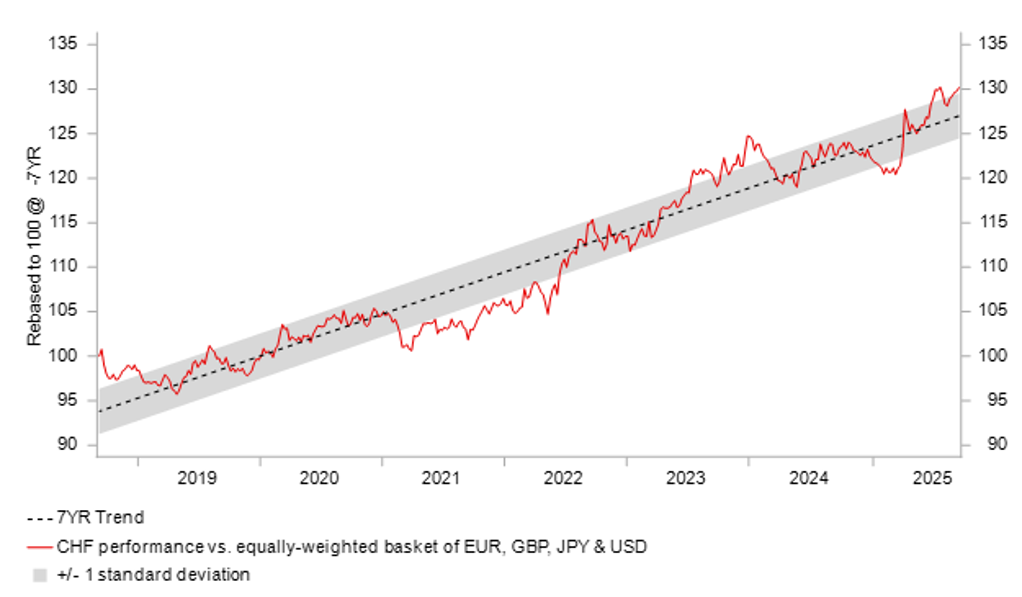
Source: Bloomberg, Macrobond & MUFG GMR
NEGATIVE SNB RATE SPECULATION HAS EASED
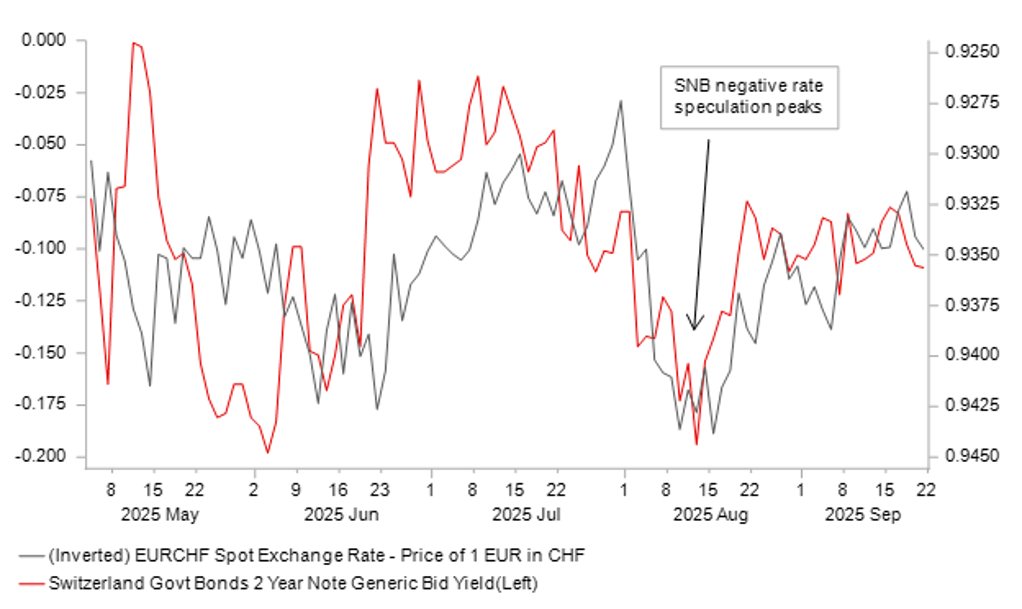
Source: Bloomberg, Macrobond & MUFG GMR
Weekly Calendar
|
Ccy |
Date |
BST |
Indicator/Event |
Period |
Consensus |
Previous |
Mkt Moving |
|
AUD |
22/09/2025 |
02:00 |
RBA's Bullock-Testimony |
!! |
|||
|
EUR |
22/09/2025 |
14:45 |
ECB's Lane Speaks |
!!! |
|||
|
EUR |
22/09/2025 |
15:00 |
Consumer Confidence |
Sep P |
-- |
-15.5 |
!! |
|
SEK |
23/09/2025 |
08:30 |
Riksbank Policy Rate |
-- |
2.00% |
!!! |
|
|
EUR |
23/09/2025 |
09:00 |
ECB's Muller Speaks |
!! |
|||
|
EUR |
23/09/2025 |
09:00 |
HCOB Eurozone Manufacturing PMI |
Sep P |
-- |
50.7 |
!!! |
|
EUR |
23/09/2025 |
09:00 |
HCOB Eurozone Services PMI |
Sep P |
-- |
50.5 |
!!! |
|
GBP |
23/09/2025 |
09:30 |
S&P Global UK Manufacturing PMI |
Sep P |
-- |
47.0 |
!!! |
|
GBP |
23/09/2025 |
09:30 |
S&P Global UK Services PMI |
Sep P |
-- |
54.2 |
!!! |
|
USD |
23/09/2025 |
13:30 |
Current Account Balance |
2Q |
-- |
-$450.2b |
!! |
|
USD |
23/09/2025 |
14:45 |
S&P Global US Composite PMI |
Sep P |
-- |
54.6 |
!! |
|
CAD |
24/09/2025 |
19:30 |
Speech: Tiff Macklem, Governor |
!!! |
|||
|
AUD |
24/09/2025 |
02:30 |
CPI YoY |
Aug |
2.9% |
2.8% |
!!! |
|
EUR |
24/09/2025 |
09:00 |
Germany IFO Business Climate |
Sep |
-- |
89.0 |
!! |
|
USD |
24/09/2025 |
15:00 |
New Home Sales |
Aug |
655k |
652k |
!! |
|
CHF |
25/09/2025 |
08:30 |
SNB Policy Rate |
0.00% |
0.00% |
!!! |
|
|
CHF |
25/09/2025 |
09:00 |
SNB's Schlegel Speaks |
!!! |
|||
|
EUR |
25/09/2025 |
09:00 |
M3 Money Supply YoY |
Aug |
-- |
3.4% |
!! |
|
GBP |
25/09/2025 |
11:00 |
CBI Total Dist. Reported Sales |
Sep |
-- |
- 28.0 |
!! |
|
USD |
25/09/2025 |
13:30 |
Advance Goods Trade Balance |
Aug |
-$95.6b |
-$102.8b |
!! |
|
USD |
25/09/2025 |
13:30 |
GDP Annualized QoQ |
2Q T |
3.3% |
3.3% |
!! |
|
USD |
25/09/2025 |
13:30 |
Durable Goods Orders |
Aug P |
-0.8% |
-2.8% |
!! |
|
USD |
25/09/2025 |
13:30 |
Initial Jobless Claims |
20-Sep |
-- |
-- |
!! |
|
USD |
25/09/2025 |
15:00 |
Existing Home Sales |
Aug |
3.98m |
4.01m |
!! |
|
JPY |
26/09/2025 |
00:30 |
Tokyo CPI YoY |
Sep |
2.9% |
2.6% |
!! |
|
CAD |
26/09/2025 |
13:30 |
GDP MoM |
Jul |
-- |
-0.1% |
!!! |
|
USD |
26/09/2025 |
13:30 |
Personal Spending |
Aug |
0.4% |
0.5% |
!! |
|
USD |
26/09/2025 |
13:30 |
Core PCE Price Index MoM |
Aug |
0.2% |
0.3% |
!!! |
|
USD |
26/09/2025 |
15:00 |
U. of Mich. Sentiment |
Sep F |
55.4 |
55.4 |
!! |
Source: Bloomberg & MUFG GMR
Key Events:
- The SNB’s latest policy meeting in the week ahead will be watched closely after the SNB lowered rate back to the zero bound at their last meeting in June. We expect the SNB to leave rates on hold in the week ahead although there is a non-negligible risk they may consider lowering rates back into negative territory. Inflation in Switzerland is still well below the SNB’s target and downside risks to growth and inflation have increased recently after the Trump administration put in place a tariff on imports from Switzerland of 39%. Recent comments from SNB officials including Governor Schlegel have indicated the hurdle to reintroducing negative rates is high, and that it is a much bigger step than a normal rate reduction.
- The Riksbank’s policy decision in the week ahead is judged to be close call with market participants weighing up whether the Riksbank will deliver another 25bps cut or leave rates on hold. At last month’s policy meeting, the Riksbank continued to signal that it still sees “some probability of a further interest rate cut this year”. Economic data releases since then have been mixed. Economic growth in Sweden in Q2 was stronger than expected while on the other hand inflation slowed in August supporting the Riksbank’s view that the recent pick-up was likely temporary. On balance we expect the Riksbank to cut rates by 25bps although they may wait a little longer until November or December.
- The main economic data releases in the week ahead are: i) the latest PMI surveys from the euro-zone and UK for September, ii) monthly CPI report from Australia for August, iii) monthly GDP report from Canada for July, and iv) the core PCE deflator report from the US for August.
